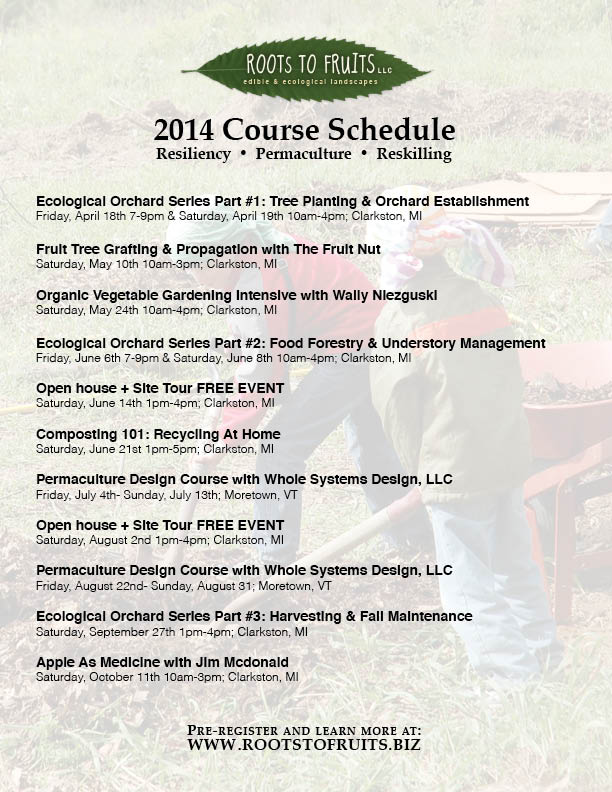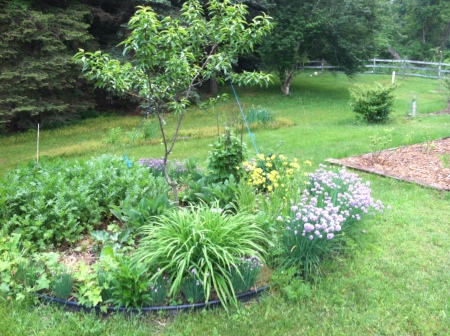I’ve finally gotten around to posting the Roots To Fruits 2014 schedule of events! We are psyched to be offering many exciting classes and workshops in the coming year. More information for each event will be posted to the RTF website soon. Stay posted for registration details…
Category: Roots To Fruits
Fruit Tree Polycultures: Summer Pomona Feature
POMONA
The Member-Written, Quarterly Journal of North American Fruit Explorers (NAFEX)
Vol. XLVI, No. 3, Summer 2013
Fruit Tree Polycultures
Trevor Newman
tnewman92@gmail.com
(P) 248-535-9419
(F) 248-625-7676
The Fruit Nut | http://www.thefruitnut.com
Unlike monocultures, polycultures contain diverse mixtures of species growing together in symbiosis. Creating polycultures around fruit trees can reduce the need for offsite inputs, increase biodiversity in the orchard, and provide various secondary yields such as medicinal herbs, perennial vegetables, and much more. Establishing polycultures around fruit trees is all about analyzing the needs of the tree and matching those needs to the functions of various support species or ‘companion plants.’ The aim is to provide the basic needs of the tree (fertility, pest management, weed control, etc.) by using biological
resources. Instead of ‘planting a fruit tree,’ we can think of this integrated approach as ‘planting an ecosystem’.
Dynamic accumulators are plants whose deep taproots mine hard-to-reach minerals from the soil and deposit them in their aerial parts. These plants can be grown around the base of fruit trees and managed on a ‘chop-n-drop’ basis whereby their aerial parts are occasionally cut and spread as mulch directly beneath the trees. Comfrey (Symphytum officinale) is a great example of a dynamic accumulator that is high in calcium, phosphorus, and manganese. I put at least one comfrey plant at the base or around the
drip line of each tree and generally cut them back for mulch 3-4 times throughout the growing season.
Nitrogen-fixing plants are commonly used in organic agriculture as cover crops and green manure. The same principles can be applied to the orchard by using nitrogen fixing trees, shrubs, and herbs to act as nurse crops for young fruit trees. A great multi-purpose nitrogen fixer is goumi (Eleagnus multiflora), which produces an early-season berry and provides an abundance of nectary flowers which honeybees
love. When goumi and other nitrogen fixers are cut down, their roots respond by releasing a plume of nitrogen into the surrounding soil. Fruit trees and other crop plants can tap into this fertility source.
Groundcover plants are excellent weed suppressors and should be integrated throughout the orchard understory to act as living mulch while excluding any potential for weeds to grow. Applemint (Mentha suaveolens) and white clover (Trifolium repens) are two groundcovers that can be effectively integrated with orchard grass to create a dense mat. Creeping comfrey is an excellent groundcover that spreads
indefinitely, can tolerate shade, and also serves as a dynamic accumulator.
Another class of functional plants are known as insectaries. These are plants that provide fodder for beneficial and predatory insects. By attracting these ‘good guys’ to the orchard we can increase pollination and limit pest outbreaks by encouraging a balance among predator and prey populations. Plants in the Apiaceae family (carrot, lovage, etc.) and plants in the Asteraceae family (yarrow, coneflower, etc.) are especially good at attracting predatory insects like parasitic wasps, lace wings, and lady beetles. Having insectary plants flowering at different times throughout the year ensures that beneficial insects will have a plentiful supply of food and reason to stick around.
The core of good polyculture design lies in a basic understanding of ecology and plant functions. Polycultures mimic functional interconnections found in natural ecosystems while producing an abundance of yields and reducing off site inputs. Visit www.apiosinstitute.org to see numerous case studies and find out more about designing fruit tree polycultures.
Fall Closure, Garden Update, & New Podcast
Winter is coming and you can feel it in the air. While Hurricane Sandy was wreaking havoc on the east coast Michigan got hit with serious winds, heavy rain, and some hail. That storm swooped away the remaining tree leaves bringing a conclusion to the beautiful display of fall colors. Now the bareness is kicking in. I’ve been struggling to find time to write amongst the busyness of closing down the gardens and getting everything ready for winter. You have to make hay when the sun shines- soon enough we’ll be snowed in.
A LOT has been going on, though. Many renovations have been made in the garden/orchard as well as some new plantings. My company has been doing well this fall and we’ve hosted some exciting workshops and secured some enthusiastic new clients that are ready to take on and transform their own landscapes. The elections have just passed, thankfully, and obviously everybody has their different views on voting…but we can all use this time as a reminder that perhaps the most effective way to vote and cast your voice is with your everyday actions. ‘Vote with your dollar’ is a powerful saying. We all have an opportunity to be the change we wish to see. Make positive changes in your own community, small or large.
 Thats a wrap for my political rant; this is after all a website about fruit and orcharding, not politics. I vote for apples. Speaking of apples, I just finished the latest episode of the The Fruit Nut Podcast with Michael Phillips, the author of The Apple Grower and The Holistic Orchard. It was a great conversation and Michael shared so much valuable information. We talked about holistic fruit tree care, community orchards, and more. CLICK HERE to listen to the interview. Unfortunately the past three episodes have been recorded with a low quality microphone so the audio on my end breaks up a lot and doesn’t sound that great. HOWEVER, I am investing in a new recording system to produce much cleaner audio. Look forward to episode 4 with Lee Reich.
Thats a wrap for my political rant; this is after all a website about fruit and orcharding, not politics. I vote for apples. Speaking of apples, I just finished the latest episode of the The Fruit Nut Podcast with Michael Phillips, the author of The Apple Grower and The Holistic Orchard. It was a great conversation and Michael shared so much valuable information. We talked about holistic fruit tree care, community orchards, and more. CLICK HERE to listen to the interview. Unfortunately the past three episodes have been recorded with a low quality microphone so the audio on my end breaks up a lot and doesn’t sound that great. HOWEVER, I am investing in a new recording system to produce much cleaner audio. Look forward to episode 4 with Lee Reich.
Here are some recent photos of field trips, events, and happenings in the garden…





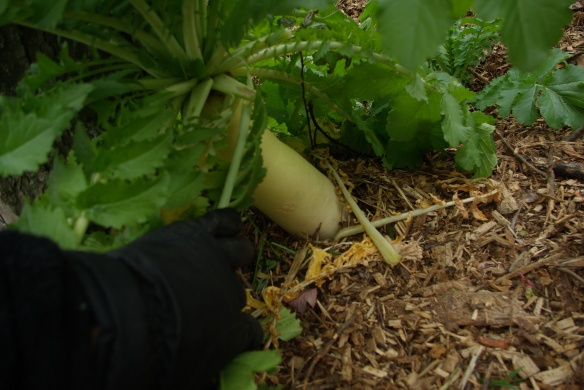












October Update: New Podcast, Articles, & More!!!
Now the autumnal shift is fully present and unavoidable as the trees show their gorgeous display of fall colors and days get cooler. However this is still a busy time of year…even with some 75% of the fruit crops wiped out there is still a bit to harvest. Before we take a look at that, I’d like to announce the addition of two new pieces to the Articles page, one titled Making Ink From Berries by guest writer Dana Driscoll, and the other a small-scale alley crop photo essay by yours truly. Speaking of new content, I am also excited to share with you my latest audio podcast with the American persimmon fanatic, Jerry Lehman! Click here to listen to the podcast and stay tuned for Episode 3 with Michael Phillips, the author of The Holistic Orchard.

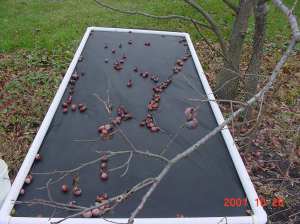


That pretty much covers the latest in terms of new content. Was at a client’s site the other day doing a check up and found some exciting things. This was a site we installed 3 years ago and haven’t gone back much since then, so whenever we make a visit its always surprising to see whats done well. While visiting we also decided to harvest autumnberries from a bountiful population along the edge of her street. Here are some photos from that adventure…
CLICK HERE to learn more about this project!








Autumnberry is a truly abundant wild food that is loaded with nutrients and so widely available. More people need to start harvesting it. There is a big debate with autumnberry and many other plant species— some folks believe eradication is necessary because these plants are “invasive”, which is an entirely non-scientific claim that lacks any ecological footing. This is a big issue and we won’t get into it too much right now, but I would like to point out one thing. In the case for autumnberry, the plant arrived to NA back in the 70’s and was promoted largely by the USDA and conservation districts, NOW the same folks who encouraged the planting and dissemination of autumnberry are the ones promoting its eradication…SO, to me it seems only rational to NOT put full trust in these organizations and institutions. Who knows what will happen 30 years from now if herbicide applications are continued in radical attempts to eradicate opportunistic plants? All I am saying is we need to be incredibly mindful when we intervene on this level and have great forethought into potential future outcomes…good or bad. That concludes my rant for now.


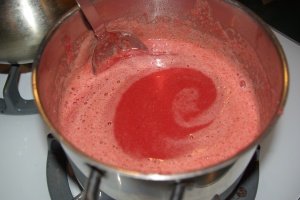
Speaking of jam, just the other day I harvested some mountain ash berries from a tree my parents planted some 25+ years ago. The yields were down this year but there was

enough to experiment making a small batch of jam. If you’ve ever tried mountain ash berries then you know they’re incredibly astringent and barely palatable(there are some varieties and hybrids which are better for eating). In past years I’ve made mountain ash mead and used the tree as a rootstock for shipova(more to come on that soon). But I never really ‘ate’ the berries. So I tried making a batch of jam…and…it tastes awful. No matter how much sugar you add the astringency just intensifies. Supposedly the berries get sweeter with a frost… and they are said to be high in vitamin C. I think its more useful as medicine then food.
Another not-so-edible berry…is the yew berry. Which in fact contains a highly poisonous seed…but the red jelly-like flesh is said to be edible. And it is edible, I am living proof. Out of curiosity I began nibbling on the berries this fall and I found they’re actually quite good! Very sweet with a mild flavor. The texture is slimy. An interesting relative that I’ve only read about is Japanese plum yew(Cephalotaxus harringtonia); this one is said to produce larger fruits that are fully edible, seed and all.
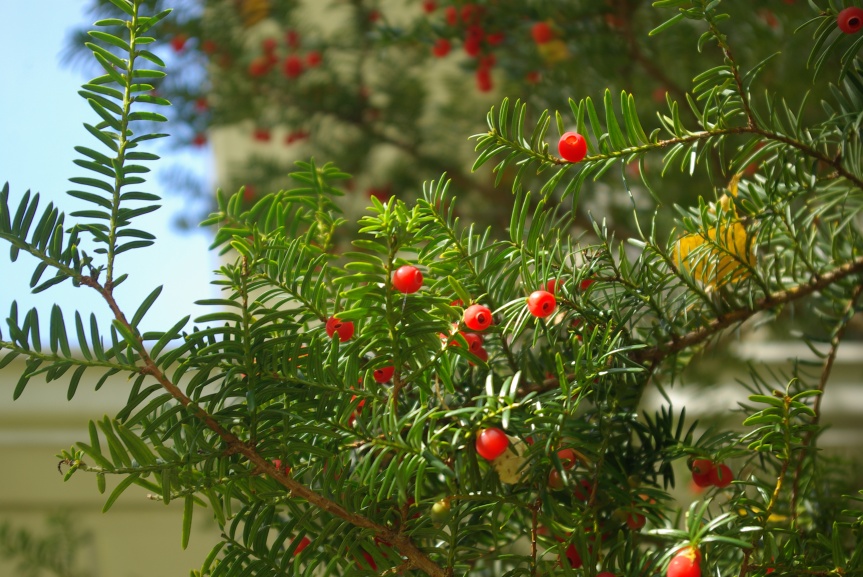


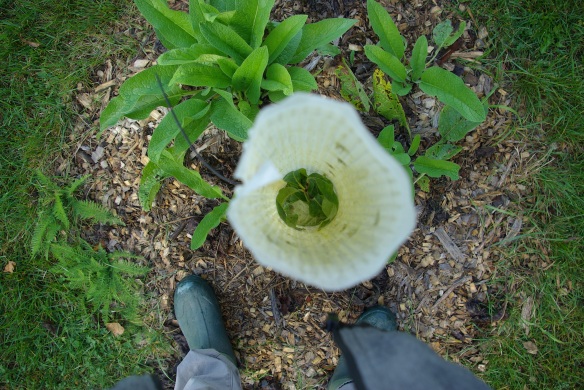

Fall IS Here, But Apples Are Not…
Today marks the autumnal equinox and now its official— fall is here! In retrospect the summer seemed to have went by in fast motion as it started abruptly with an early spring and now its concluding just as swiftly. These periods of drastic change are incredibly powerful and sometimes the shifting energy can be difficult to deal with but we try our best. I have been traveling for the past few weeks, first on a trip to VT to stay at Whole Systems Design research farm and then touring throughout northwest MI doing some consulting, seminars, and catching up with friends and colleagues. Summer seems to have ended during the weeks on the road and now that I’m back its satisfying to spend time walking through the gardens observing, harvesting, and contemplating. There is still a lot to be had for the 2012 gardening season but cold nights dipping into the low 40’s pose major threats to those vine-ripening tomatoes and unripe figs(which sadly won’t ripen). Its the time of year to move inward, wether that means collecting your ideas and dreams, or storing away the season’s bounty. In the next couple weeks I will be making jams & jellies, fermenting cabbage, carrots, and other root vegetables, as well as putting up other storable food items for the cold months ahead. The squirrels are busy burying nuts, luckily for them(and us!) its a bumper crop year for oaks. The best part is that sometimes they forget these burial sites and VOILA a cluster of oak trees appear a few seasons later. Ever since I’ve been growing fruit and gardening in general, this season stands out as the most unusual in terms of weather conditions, ripening dates, and so on. In the old apple orchard on my families land not an apple can be found. Not to say that all of the apples in SE MI were a bust, but these particular trees set very few if any. On a recent visit to a friend’s orchard outside of Ann Arbor, I discovered that his plum, apricot, peach, pear, and apple trees didn’t set a single fruit. On the contrary, the other day while driving through the hilly landscape of the grand Traverse bay in northern MI, the roadside orchard trees were laden with ripe apples. Perhaps this protected fruit growing region has somewhat of a buffer. Either way, its been an odd and eye-opening year. I keep thinking back to a principle we share in our Roots To Fruits talks…it goes: Value Diversity; we then expand and talk about the different facets of diversity(functional,biological,genetic,etc.) and the many values of having a diverse landscape, but now I’m referring to crop diversity in a garden-orchard. Its one of those years you wish you would’ve over-planted. Another interesting idea comes to mind that I’d like to share with you. While having a conversation with my buddy Ben Falk, he mentioned that there is a lot of talk about how tree-based agriculture is highly resilient in the face of an unpredictable climate and other instabilities but really when we depend on fruit, mast, or nut-producing trees we’re actually relying on the most delicate and vulnerable manifestation of nature— a flower. He makes a good point, and it can be clearly seen this year with crop loss due to drought, late frosts, and other climatic conditions. This reinforces the necessity for planting late-flowering trees like American persimmon and chestnut. I digress.
Several exciting ideas are brewing for new blog posts and articles so keep an eye out over the next couple weeks and expect much more as we move into the winter months. I will have some amazing guests coming on the podcast as well. For now I’ve decided to share some recent photos with quick captions that will hopefully give you an idea of what I’ve been up to as of late. May you have a happy and healthy seasonal transition!





















New Moon: Ground Cherries, Orgonite, Black Currant Tincture, and More…
Its been a few weeks since my last post and I’ve been itching to release some fresh ideas and photos. Things have been a bit crazy lately with selling plants at the farmers markets and working on new Roots To Fruits jobs. Its all very good, just a bit tiring at times. So now, on this new moon, I’ve found some time to put out. Just as everything goes in phases and cycles so does my motivation to write, and with the waxing moon my energy towards writing and managing the blog is on the rise! So expect some frequent posting over the next few weeks.
Its mid-august and the groundcherries in my garden are starting to litter the ground once  again. This has been a tradition for the past several seasons; in fact last year the garden was so inudated w/ self-seeded ground cherries, that access became an issue! But what are ground cherries? Being a member of the Solanaceae family they bear some resemblance to tomatillos or cherry tomatoes except with a much fruitier flavor. Botanically speaking tomatoes are technically a fruit, although they’re often referred to as a vegetable…groundcherries, however, don’t fall short of the fruit category. The common ground cherry(Physalis peruviana), also called cape gooseberry, not to be mistaken with true gooseberries(Ribes spp.), is a self seeding annual that can become rather weedy. Physalis heterphylla is a perennial relative that grows wild throughout eastern NA. I have
again. This has been a tradition for the past several seasons; in fact last year the garden was so inudated w/ self-seeded ground cherries, that access became an issue! But what are ground cherries? Being a member of the Solanaceae family they bear some resemblance to tomatillos or cherry tomatoes except with a much fruitier flavor. Botanically speaking tomatoes are technically a fruit, although they’re often referred to as a vegetable…groundcherries, however, don’t fall short of the fruit category. The common ground cherry(Physalis peruviana), also called cape gooseberry, not to be mistaken with true gooseberries(Ribes spp.), is a self seeding annual that can become rather weedy. Physalis heterphylla is a perennial relative that grows wild throughout eastern NA. I have

found them growing a few times in MI, and Ken Asmus of Oikos Tree Crops now sells the perennial form. Even the annual forms seem to ‘perennialize’ in the sense that they volunteer each year and reliably come back. They’re called ground cherries because they fall to the ground when fully ripe. They can then be collected, dehusked, and eaten fresh. I’ve also heard them called husk cherries because they grow inside a papery protective husk. Nature’s wrapper. The flavor is like the sweetest of tomatoes with fruity-pineapple notes. They are about the size of a grape tomato and contain several small seeds which are barely noticeable. Ground cherries are great dehydrated and I’ve been toying with the idea of using them in salsa, jelly, and wine. Mmmm…

Now that summer has peaked and is waning, we’ve concluded most of the berry pickin’; cane fruits are pretty much done, besides the fall bearing raspberries, blueberries are dwindling but still available, and the Ribes, besides the latest of gooseberries, are now a distant memory. Fortunately they’re blessings are preserved in jams and jellies! The

changing seasons can be difficult to deal with, but its a righteous reminder of the impermanence of all things. Actually its a good way to practice non-attachment. I really, really, am enjoying all of these wonderful zucchinis, but they too will pass! Nothing lasts forever and thats the beauty of it. As small fruits and berries are largely coming to an end, the stone fruits are coming in, and early apples are beginning to ripen. I was in Detroit two weeks ago and was

delightfully surprised to find the number of ripe apples. The odd season paired with the Detroit microclimate created super conditions for tree fruit. Even the peaches weren’t phased by the early season warm spells and late frosts. We even found peach seedlings setting fruit in alleys. Want to start growing fruit? Move to Detroit.



My peach trees didn’t set any fruit this year. Fortunately a few local growers managed to get a small percentage of the usual crop…just enough to bring to market. So the past two weeks I’ve been buying containers of peaches at the market. I belong to a goat milk share where I get a half gallon of organic raw goat milk each week. This week I decided to make some fresh cheese… I was left with a lot of whey. Today I made a lovely smoothy with one cup blueberries, two peaches, and one cup whey. No whey, yes whey… rich in flavor and rich in nutrients!

As promised, here is the blueberry-lavender jam recipe…very simple, no fuss recipe. Give it a try!
What You’ll Need:
- 8 cups fresh blueberries
- 1.5 cups organic sugar
- 1 tablespoon lavender flowers
- 1/4 cup lemon juice
Process:
Step #1: Crush washed blueberries in large cooking pot. Cook on medium heat for 5 minutes.
Step #2: Add sugar and lemon and bring to a boil. Reduce heat, add lavender and cook for 10-15 more minutes on medium heat. Stir consistently.

Step #3: Take off heat and fill jars; store in fridge or for long-term storage place jars in boiling water bath for 15 minutes.
Tips: some recipes suggest removing foam as the jam cooks; I’ve found blueberries to be low foam producers making this step unnecessary.

I choose to plant based on the moon using the biodynamic calendar AKA the Stella Natura. I’ve found much satisfaction(not to mention great results) in following the solunar calendar for my gardening activities. I also make medicine preparations like tinctures and salves on the new moon as to foster the lunar energy put out increasingly from that time until the next full moon. Aside from food, I’ve been curious about the medicinal uses of fruiting plants. Strawberry leaf is a great astrigent used in skin care products, raspberry leaf is high in tannins and has a slew of medicinal actions, and lastly, what I’m concerning myself with today— black currant leaf. Aside from the potent nutraceutical properties of Ribes nigrum fruit, the leaves also possess strong medicinal properties. According to one resource, “Black currant dried leaf is used for arthritis, gout, joint pain (rheumatism), diarrhea, colic, hepatitis and other liver ailments, convulsions, and disorders that cause swelling (inflammation) of the mouth and throat. Black currant dried leaf is also used for treating coughs, colds, and whooping cough; disinfecting the urine; promoting urine flow; treating bladder stones, and as a cleansing tea.” The leaves are astringent and have been used for treating skin blemishes like acne and eczema. Since the plants are just hanging out now and all the berries are long picked, I decided to harvest some leaves for making an alcohol extract.


The late Frank Cook talks briefly about the edible and medicinal uses of black currant…
An exciting new project recently sprouted forth after connecting with a local friend and fellow entrepreneur, Josh Cook. His company, Source Reality, offers products and service for facilitating individuals in connecting to their deepest nature, and reuniting with the source. They offer astrology readings, reiki healing, orgonite, and more. According to the Source Reality website: “Orgonite is the name given to powerful devices which attract negative etheric energy and transmute it into positive, life-giving energy. This is done through a mixture of metals and crystals that are sealed in a resin and formed in specific molds…”

Visit their website to learn more about these unique energy devices. We’re collaborating to do a research experiment using orgonite for influencing plant growth. I’ve conducted a small trial with two hardy kiwi vines grown in containers under identical soil, water, and light conditions… one, however, has an orgonite mold placed in the bottom of the 1gallon pot. We hypothesize that the energetic workings of the orgonite may effect plant growth in some way. Stay tuned for results.


The sun set is telling me to conclude this post and unwind for the evening. Please check back soon for more exciting posts, new articles, and upcoming audio podcasts! Happy growing…
Thai Basil + Red Currant Jelly !!!
Red currant jelly is highly regarded in European cuisine and for righteous reasons. In the Lorraine region of France you’ll find the sought after bar-le-dec jelly which is specially prepared with currants that have been deseeded by an epepineuses. In other traditions red currant jelly is served with lamb and different meat dishes. I relish red currant jam and thats what I’ve been making the past few years. In fact I still have some jars stored away from last season’s crop. However this time I wanted to make jelly instead. To me jelly is a bit more of a ‘premium’ since the seeds and skins are removed and it takes considerably longer to make. I was looking to spice it up by adding a flavoring herb; I decided on Thai basil. This is one of my favorite basil varieties because I love its strong anise flavor and aroma. This needed to be a low-sugar recipe as I cannot buy into the ridiculous amounts of sugar suggested for most jam and jelly recipes. It would be an awful shame to mask the complex tartness of the currants.
Here’s what you’ll need for this simple recipe:
- 8 cups destemmed currants
- 1/2 cup water
- 1 1/2 cups organic cane sugar
- 1 handful of thai basil leaves and flower tops
- 2 tbsp powdered pectin
Currant Affairs 7/9/12
After being gone for a few days up north I was disappointed to return and find my ‘Rovada’ red currants and ‘Primus’ white currants had almost entirely disappeared. I’d been waiting to harvest them at their peak ripeness, but apparently I waited too long and the birds beat me to it. Even with the red currants being haphazardly netted the birds still found a way to devour. Bummer. Can’t stress it enough when it comes to harvesting: TIME IS OF THE ESSENCE!

Fortunately mother nature had a back up plan and the local ‘U-Pick’ red currant put on a bumper crop which the birds haven’t bothered (yet). ‘U-Pick’ is a bush I found a few years ago at a friend’s house and have been trying to uncover it’s origin. It was planted some 27+ years ago by the previous homeowners. For not being pruned and fending for itself, she’s managed to produce a bountiful crop for the past several years. Stay tuned for an upcoming red currant jam recipe. In the meantime check out how my friend Mark has been using red currants in some gourmet fixins!

Thankfully I was smart enough to pick the last of my ‘Pink Champagne’ currants before I went on my trip north. Otherwise they too would have been gone I suspect. Guests ate the currants and everyone enjoyed their sharp tanginess! I juiced the left over berries and mixed up a currant cosmopolitan with vodka, currant juice, lime, and a touch of sparkling water. Twas a lovely cocktail.


My everbearing golden raspberries are ripening their first flush of fruit for the season. I have been eating a generous handfull daily for the past week. There has been a lot of interest in golden raspberries at the Clarkston Farmers’ Market lately. Its always fun to show people an unusual version of a food they’re already familiar with.

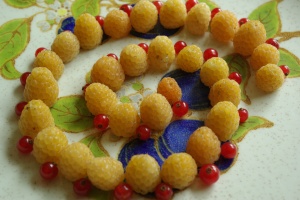
The black raspberry season has been unusual thus far; there appears to be a good fruit set but they’re taking their sweet time to ripen. So there has yet to be any golden opportunities to cash in on the harvest. However, when I was out looking the other day I came across a stunning patch of wild bergamot and some happy, happy bumble bees!!!

One of the biggest thrills yet has been the blueberry harvest. Highbush blueberries are ripe for the picking and I will dedicate an entire post to that SOON!

Berries, berries, and more berries!
The heat of summer is in full swing, and the berry season is starting to pick up. With such a strange winter and spring the ripening times aren’t ‘normal’, or more accurately aren’t as they’ve been in years past. With that being said, tis the season for berry picking! Take it when it comes and do your darndest to best utilize mother nature’s abundance of nourishing and tasteful summer fruits! I’ve been doing just that…
Several days ago on a bike ride with my friend Paris Rae, we came upon a lovely patch of Ribes odoratum, or clove currant. This is a black currant species indigenous to NA with large, shiny black berries that are highly aromatic with a wonderful spicey-sweet flavor. A truly delectable roadside find!
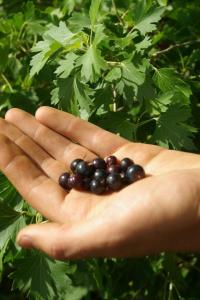
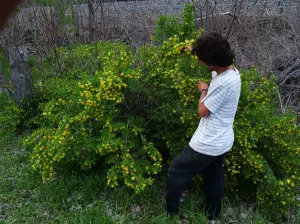
For the past 3-4 weeks I’ve been consuming plenty of European black currants (Ribes nigrum) of which I absolutely indulge upon and relish their complex ‘foxy’ flavor! Five varieties grow in my garden which all ripen at slightly different times, and today I picked the last of ’em from ‘Consort’. The bushes hold onto to their fruit quite well for the duration of picking season, which is a nice characteristic. This cannot be said for softer fruits like raspberries. I was meaning to make a batch of black currant jelly, but instead ended up eating them all fresh out of hand and mixed in salads. I love to let visitors try the black currants and observe their reaction. Most people enjoy them.
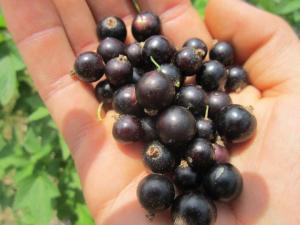
On hot days like today I like to make a refreshing iced berry drink. Today I made one with black currants. It is a simple recipe and you can alternate black currants with any other berry. This is all you’ll need:
- 1 cup fresh berries
- 1 cup crushed ice
- A spoonful of organic raw honey never hurts
I use a magic bullet with the heavy duty blade; you can use a blender, vita-mix, or whatever you’ve got! Mix the ingredients and blend. Sometimes you’ll need to add a small amount of water or other liquid to get the blending started.
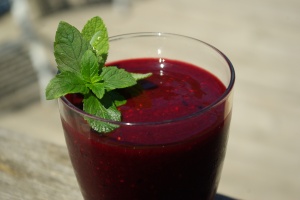
Blackcaps, or black raspberries, are reaching their peak season. They happily grow wild around here and if you know a good spot then there is usually never a shortage of berries. I like to freeze them for use in pies and smoothies during winter. They also make a delicious low-sugar jam.
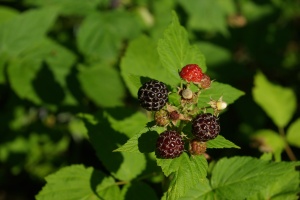
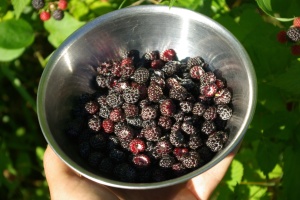
I expect the next two weeks to be the ideal time to collect a lot of these gems for freezing and preserving. Once you familiarize yourself with these fruits you’ll learn that its all about timing and it surely pays to keep a close eye on whose ripening!
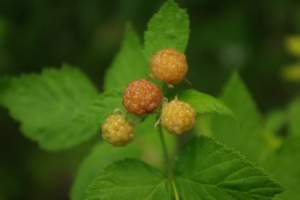
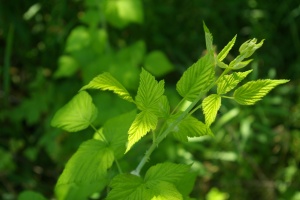
In my garden it is an ‘in-between’ year for strawberries. My strawberry bed was renovated this spring so it won’t be in production again until next year. Fortunately I have a lot of alpine strawberries still producing. Alpine strawberries are the wild european strawberry. Similar to the woodland strawberries you find growing here. Small fruit that packs a serious punch. Red and white-fruited varieties exist and their everbearing tendency keeps fresh berries comin’ all season! The ones in the image below were picked from a local edible landscape installed by Roots To Fruits. Stay tuned for a coming article on alpine strawberries
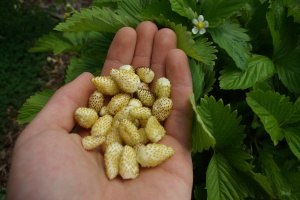
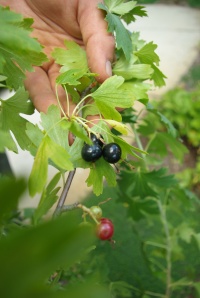
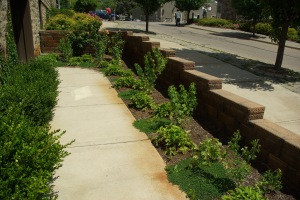
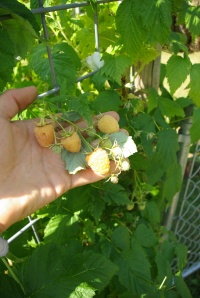
One of the nice things about white-fruited berries vs. red,purple/blue hues is that they appear to be less noticeable to birds. Birds tend to recognize red and purple as something to go for where white and yellow, from my experience- are left alone. White alpine strawberries and golden raspberries are great from that regard. Another nice white-fruited berry is white currant. Technically white currants are just a variant of red currant (R.rubrum). I have a few varieties in my garden and most of them are all gone by now as they ripen much faster then reds(which are just starting to ripen). However a later ripening variety by the name of ‘Primus’ lives in my garden, and she is just now starting to ripen her berries(no currants are not dioecious!).
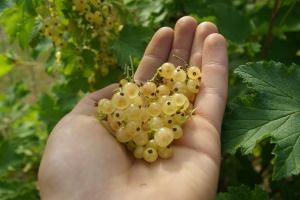
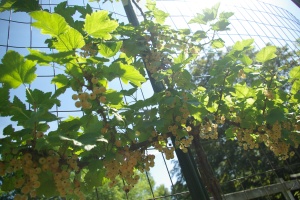
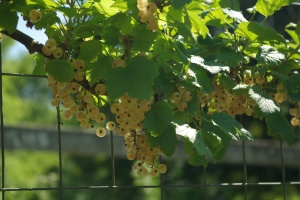
It has been a sad season for my gooseberries. I set out nearly 15 new bushes this year and they’ve had a rough go thus far. But its mainly my fault. They were planted in an area where horses and deer live and apparently the fencing system was not adequate. Aside from being trampled on a few times, there’s also been a serious outbreak of small green worms which defoliate a plant in a number of days. Not sawfly, still needs ID. If anyone knows please share.
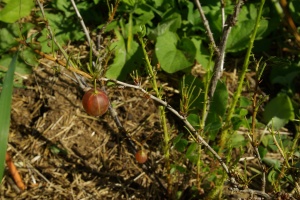
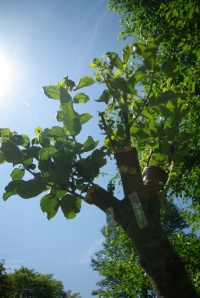

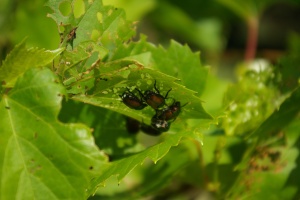
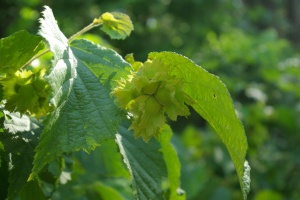
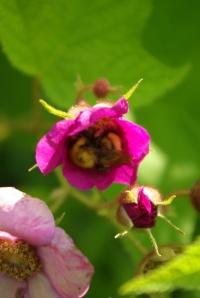
Comfrey For The Garden & Orchard
Comfrey is a plant with a multitude of uses not only in the home apothecary but also in the garden. There are several species in the genus Symphytum, all of which merit special attention, but generally S. officinale, or common comfrey, and a hybrid species S.x uplandicum are most often used. The ladder of which is particularly suitable for the home garden because it is sterile and doesn’t spread by seed. The most available variety is called ‘Bocking 14’. These are upright comfreys which can grow 5′ tall. There are also rhizomatous species which only grow 6″-1′ high and spread to form a dense groundcover.
Comfrey is prized amongst herbalists for its incredible healing powers. Comfrey leaves and roots

contain a high concentration of allatoin– a substance that speeds cell renewal. It got the colloquial name ‘knitbone’ for its use in treating wounds and reducing inflammation from broken bones and sprains. It’s not a surprise that comfrey fulfills a similar ecological niche working to heal wounded and degraded soils. Comfrey is referred to as a mineral accumulator or dynamic accumulator for its ability to mine nutrients with its deep roots (which also loosen compacted soils). Those nutrients are then deposited in the aerial parts of the plant; being especially high in potassium, phosphorus, calcium, and nitrogen. When the aerial parts die back in the fall those nutrients assimilate into the surrounding soil. Gardeners can facilitate this process by intentionally cutting the plant down at strategic times for use as mulch around fruit trees, berry bushes, or in the veg garden. In the permaculture world we


refer to this process as ‘chop-n-drop’. Plant comfrey at the base of your fruit trees and simply chop-n-drop the material right in place; breaking the leaves and stalks into smaller pieces will accelerate decomposition but is not necessary. This is an effective way to build topsoil rapidly and reduce off-site inputs. From my experience I’ve been able to get anywhere from 3-5 cuttings throughout the season. One fella recently told me he cuts his back 7-8 times! I like to wait for the first flush of flowers in early summer because they provide excellent bee fodder.


Another strategy for utilizing comfrey’s amazing mineral accumulating capacity is to brew a fermented comfrey tea. This is a very easy procedure which entails chopping up a few handfuls of comfrey leaves and placing them in a 5 gallon bucket with water. Cover with a lid and let the mixture ferment outdoors for 1-2 weeks. Alternatively, start the batch by pouring boiling water over the plant material and letting it steep for a few hours then adding room temp. water to fill the rest of the bucket. The hot water method seems to extract more of the nutrients. You will know its ready when it has a strong stank…a good stank! Apply with a backpack sprayer diluted or undiluted. This fermented tea can be used a foliar feed or applied directly to the soil.

I grow comfrey around my compost bins and periodically add it to new piles or existing piles to jump-start the decomposition process. I also like to think that the comfrey roots capture any leached nutrients from the compost pile. One reason some people bash on comfrey is because its nearly impossible to get rid of as the tiniest piece of root will put on adventitious buds and sprout into a new plant. Easy to propagate? Ooooh yes! Aside from comfrey’s amazing medicinal qualities and numerous garden uses, it is also a very beautiful plant that can tolerate almost any soil type and will grow well in partial shade. Some ornamental varieties include ‘Goldsmith’, ‘Hidcote Blue’, and ‘Dwarf White’. I would love to hear how you’re utilizing comfrey in your garden! Cheers.
Short video clip: Comfrey Chop-N-Drop Timing





